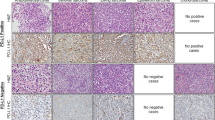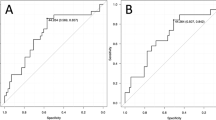Abstract
Background
Human epidermal growth factor receptor 2 (ErbB2) is overexpressed in a variety of human malignancies. Moreover, ErbB2 has been reported to influence cancer patient survival and progression of different tumor entities. However, information regarding the prognostic impact of ErbB2 in soft tissue sarcoma (STS) patients is limited and conflicting.
Material and methods
ErbB2 mRNA and protein levels were defined by quantitative real-time PCR and enzyme-linked immunosorbent assay (ELISA), and the prognostic impact of ErbB2 mRNA and protein levels in tumor tissue of 124 soft tissue sarcoma patients were investigated.
Results
The median ErbB2 mRNA expression level in tumor tissue was decreased 3.9-fold compared to non-neoplastic surrounding tissue (p = 0.001). Furthermore, an increased ErbB2 mRNA expression level was associated with an improved tumor-specific survival (p = 0.01, log rank test). Multivariate Cox’s proportional hazard regression analyses revealed an increased ErbB2 mRNA expression level as an independent favorable prognostic factor for tumor-specific survival of STS patients (n = 124; RR = 3.0; 95 % CI = 1.6–5.7; p < 0.001). In addition, multivariate Cox’s proportional hazard regression analyses showed that an increased ErbB2 protein expression level correlated with poorer recurrence-free survival of STS patients (n = 47; RR = 9.9; 95 % CI = 1.7–59.7; p = 0.012), in particular for STS patients who received postoperative radiotherapy (n = 27; RR = 17.9; 95 % CI = 1.3–247.7; p = 0.031).
Conclusion
This study suggests an inverse prognostic value of ErbB2 mRNA and protein expression level.
Zusammenfassung
Hintergrund
Der epidermale Wachstumsfaktorrezeptor (ErbB2) wird in einer Vielzahl von humanen Malignitäten überexprimiert. Darüber hinaus beeinflusst ErbB2 das Überleben von Tumorpatienten und die Progression verschiedener Tumorentitäten. Allerdings stehen nur begrenzte und widersprüchliche Daten zur prognostischen Bedeutung des ErbB2 in Weichteilsarkompatienten zur Verfügung.
Material und Methoden
Der ErbB2-mRNA- und Proteingehalt von 124 Weichteilsarkomen wurde mittels quantitativer Real-Time-PCR und „Enzyme Linked Immunosorbent Assay“ (ELISA) bestimmt und deren Einfluss auf das Überleben der Weichteilsarkompatienten untersucht.
Ergebnisse
Der mediane ErbB2-mRNA-Gehalt im Tumorgewebe war im Vergleich zum angrenzenden Normalgewebe 3,9-fach geringer (p = 0,001). Darüber hinaus war ein erhöhter ErbB2-mRNA-Gehalt mit einem besseren tumorspezifischen Überleben assoziiert (p = 0,01; Log-rank-Test). In multivariaten Cox-Regressionsanalysen erwies sich der ErbB2-mRNA-Gehalt als unabhängiger prognostischer Marker für das Überleben von Weichteilsarkompatienten (n = 124; RR = 3,0; 95 %-KI 1,6–5,7; p < 0,001). Multivariate Cox-Regressionsanalysen zeigen darüber hinaus, dass ein erhöhter ErbB2-Proteingehalt mit einem schlechten rezidivfreien Überleben von Weichteilsarkompatienten (n = 47; RR = 9,9; 95 %-KI 1,7–59,7; p = 0,012) und insbesondere mit einem schlechteren rezidivfreien Überleben von Weichteilsarkompatienten nach postoperativer Radiotherapie korreliert ist (n = 27; RR = 17,9; 95 %-KI 1,3–247,7; p = 0,031).
Schlussfolgerung
Diese Studie legt eine inverse prognostische Bedeutung des mRNA- und Proteingehalts von ErbB2 für Patienten mit Weichteilsarkomen nahe.



Similar content being viewed by others
References
Greve B, Sheikh-Mounessi F, Kemper B et al (2012) Survivin, a target to modulate the radiosensitivity of Ewing’s sarcoma. Strahlenther Onkol 188:1038–1047
Eckert F, Gani C, Kluba T et al (2013) Effect of concurrent chemotherapy and hyperthermia on outcome of preoperative radiotherapy of high-risk soft tissue sarcomas. Strahlenther Onkol 189:482–485
Enzinger FM, Weiss SW (1995) Soft tissue tumours. Mosby, St. Louis
Guillou L, Coindre JM, Bonichon F et al (1997) Comparative study of the National Cancer Institute and French Federation of Cancer Centers Sarcoma Group grading systems in a population of 410 adult patients with soft tissue sarcoma. J Clin Oncol 15:350–362
Moasser MM (2007) The oncogene HER2: its signaling and transforming functions and its role in human cancer pathogenesis. Oncogene 26:6469–6487
Kasprzyk PG, Song SU, Difiore PP et al (1992) Therapy of an animal-model of human gastric-cancer using a combination of anti-ErbB-2 monoclonal-antibodies. Cancer Res 52: 2771–2776
Sauer G, Deissler H, Kurzeder C et al (2002) New molecular targets of breast cancer therapy. Strahlenther Onkol 178:123–133
Olayioye MA (2001) Update on HER-2 as a target for cancer therapy—intracellular signaling pathways of ErbB2/HER-2 and family members. Breast Cancer Res 3:385–389
Guo GZ, Wang TL, Gao Q et al (2004) Expression of ErbB2 enhances radiation-induced NF-kappa B activation. Oncogene 23:535–545
Fehm T, Maul H, Gebauer S et al (2005) Prediction of axillary lymph node status of breast cancer patients by tumorbiological factors of the primary tumor. Strahlenther Onkol 181:580–586
Yarden Y, Sliwkowski MX (2001) Untangling the ErbB signalling network. Nat Rev Mol Cell Biol 2:127–137
Karunagaran D, Tzahar E, Beerli RR et al (1996) ErbB-2 is a common auxiliary subunit of NDF and EGF receptors: implications for breast cancer. EMBO J 15:254–264
Tzahar E, Waterman H, Chen XM et al (1996) A hierarchical network of interreceptor interactions determines signal transduction by neu differentiation factor/neuregulin and epidermal growth factor. Mol Cell Biol 16:5276–5287
GrausPorta D, Beerli RR, Daly JM et al (1997) ErbB-2, the preferred heterodimerization partner of all ErbB receptors, is a mediator of lateral signaling. EMBO J 16:1647–1655
Murphy CG, Morris PG (2012) Recent advances in novel targeted therapies for HER2-positive breast cancer. Anticancer Drugs 23:765–776
Foster H, Knox S, Ganti AK et al (2003) HER-2/neu overexpression detected by immunohistochemistry in soft tissue sarcomas. Am J Clin Oncol-Canc 26:188–191
Sato T, Peiper M, Heinecke A et al (2003) Expression of HER2/neu does not correlate with survival in soft tissue sarcoma. Onkologie 26:268–271
Potti A, Ganti AK, Foster H et al (2004) Immunohistochemical detection of HER-2/neu, c-kit (CD117) and vascular endothelial growth factor (VEGF) overexpression in soft tissue sarcomas. Anticancer Res 24:333–337
Nuciforo PG, Pellegrini C, Fasani R et al (2003) Molecular and immunohistochemical analysis of HER2/neu oncogene in synovial sarcoma. Hum Pathol 34:639–645
Wurl P, Kappler M, Meye A et al (2002) Co-expression of survivin and TERT and risk of tumour-related death in patients with soft tissue sarcoma. Lancet 359:943–945
Taubert H, Greither T, Kaushal D et al (2007) Expression of the stem cell self-renewal gene Hiwi and risk of tumour-related death in patients with soft tissue sarcoma. Oncogene 26:1098–1100
Hahnel A, Wichmann H, Kappler M et al (2010) Effects of osteopontin inhibition on radiosensitivity of MDA-MB-231 breast cancer cells. Radiation Oncology 5:82
Muller V, Thomssen C, Karakas C et al (2003) Quantitative assessment of HER-2/neu protein concentration in breast cancer by enzyme-linked immunosorbent assay. Int J Biol Markers 18:13–20
Hernan R, Fasheh R, Calabrese C et al (2003) ERBB2 up-regulates S100A4 and several other prometastatic genes in medulloblastoma. Cancer Res 63:140–148
Verbeek BS, Adriaansen-Slot SS, Vroom TM et al (1998) Overexpression of EGFR and c-erbB2 causes enhanced cell migration in human breast cancer cells and NIH3T3 fibroblasts. FEBS Lett 425:145–150
Zafrakas M, Zepiridis L, Theodoridis TD et al (2009) ErbB2 (HER2) protein expression in uterine sarcomas. Eur J Gynaecol Oncol 30:292–294
Amant F, Vloeberghs V, Woestenborghs H et al (2004) ErbB-2 gene overexpression and amplification in uterine sarcomas. Gynecol Oncol 95:583–587
George E, Niehans GA, Swanson PE et al (1992) Overexpression of the C-ErbB-2 oncogene in sarcomas and small round-cell tumors of childhood—an immunohistochemical investigation. Arch Pathol Lab Med 116:1033–1035
Thomas DG, Giordano TJ, Sanders D et al (2005) Expression of receptor tyrosine kinases epidermal growth factor receptor and HER-2/neu in synovial sarcoma. Cancer 103:830–838
Andrade CR, Takahama JA, Nishimoto IN et al (2010) Rhabdomyosarcoma of the head and neck: a clinicopathological and immunohistochemical analysis of 29 cases. Braz Dent J 21:68–73
Krskova L, Kalinova M, Brizova H et al (2007) Molecular and immunohistochemical analysis of ERBB2 expression in correlation with proliferation rate. in synovial sarcoma. Diagn Mol Pathol 16:211–217
Akatsuka T, Wada T, Kokai Y et al (2002) ErbB2 expression is correlated with increased survival of patients with osteosarcoma. Cancer 94:1397–1404
Ljuslinder I, Malmer B, Golovleva I et al (2005) Increased copy number at 3p14 in breast cancer. Breast Cancer Res 7:R719–R727
Underwood M, Bartlett J, Reeves J et al (1995) C-Erbb-2 gene amplification—a molecular marker in recurrent bladder-tumors. Cancer Res 55:2422–2430
Haugen DRF, Akslen LA, Varhaug JE et al (1992) Expression of C-Erbb-2 protein in papillary thyroid carcinomas. Br J Cancer 65:832–837
Gonzalez-Angulo AM, Litton JK, Broglio KR et al (2009) High risk of recurrence for patients with breast cancer who have human epidermal growth factor receptor 2-positive, node-negative tumors 1 cm or smaller. J Clin Oncol 27:5700–5706
Cao N, Li SY, Wang ZQ et al (2009) NF-kappa B-mediated HER2 overexpression in radiation-adaptive resistance. Radiat Res 171:9–21
Akatsuka T, Wada T, Kokai Y et al (2001) Loss of ErbB2 expression in pulmonary metastatic lesions in osteosarcoma. Oncology 60:361–366
Dawood S, Broglio K, Esteva FJ et al (2008) Defining prognosis for women with breast cancer and CNS metastases by HER2 status. Ann Oncol 19:1242–1248
Mittra I, Redkar AA, Badwe RA (1995) Prognosis of breast-cancer—evidence for interaction between C-ErbB-2 overexpression and number of involved axillary lymph-nodes. J Surg Oncol 60:106–111
Acknowledgments
We thank our colleagues from the Department of Radiotherapy and Department of Oral and Maxillofacial Plastic Surgery for contributing to this study and for their continuous support. We also thank Gabriele Thomas and Kathrin Spröte for their excellent technical assistance. ELISA Kits to quantify ErbB2 protein levels were kindly supported by Wilex Inc., Cambridge, MA, USA.
Author information
Authors and Affiliations
Corresponding author
Additional information
Matthias Kappler and Dirk Vordermark contributed equally to this article.
Rights and permissions
About this article
Cite this article
Wichmann, H., Güttler, A., Bache, M. et al. Inverse prognostic impact of ErbB2 mRNA and protein expression level in tumors of soft tissue sarcoma patients. Strahlenther Onkol 190, 912–918 (2014). https://doi.org/10.1007/s00066-014-0655-8
Received:
Accepted:
Published:
Issue Date:
DOI: https://doi.org/10.1007/s00066-014-0655-8




